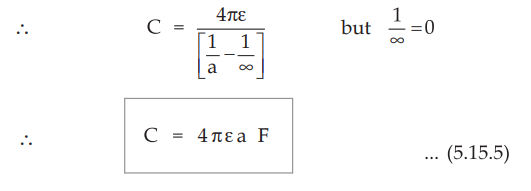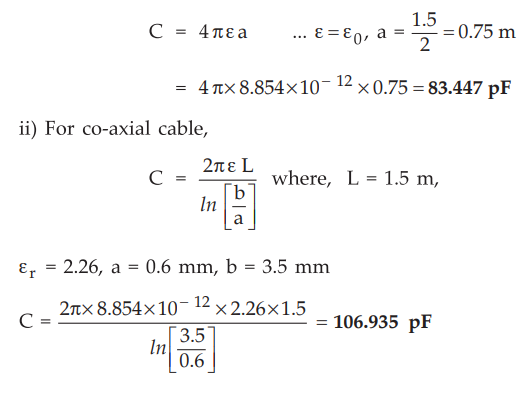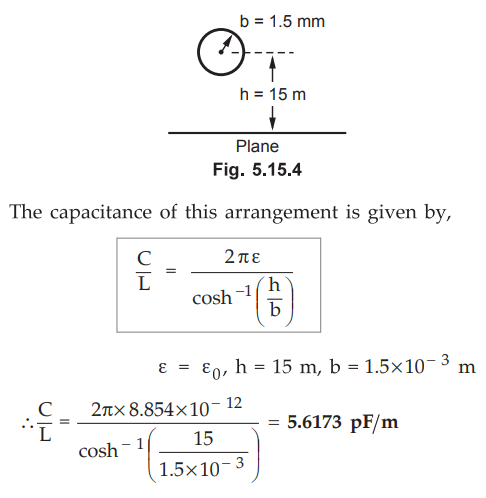Electromagnetic Theory: Unit II: (b) Conductors, Dielectrics and Capacitance
Spherical Capacitor
with Example Solved Problems
• Consider a spherical capacitor formed of two concentric spherical conducting shells of radius a and b. The capacitor is shown in the Fig. 5.15.1.
Spherical Capacitor
AU
; Dec.-03, 06, May-04, 06, 09, 19
•
Consider a spherical capacitor formed of two concentric spherical conducting
shells of radius a and b. The capacitor is shown in the Fig. 5.15.1.

•
The radius of outer sphere is 'b' while that of inner sphere is 'a'. Thus b
> a. The region between the two spheres is filled with a dielectric of
permittivity e. The inner sphere is given a positive charge + Q while for the
outer sphere it is - Q.
•
Considering Gaussian surface as a sphere of radius r, it can be obtained that ![]() is in radial direction and given by,
is in radial direction and given by,

•
The potential difference is work done in moving unit positive charge against
the direction of E i.e. from r = b to r = a.

1. Capacitance of Single Isolated Sphere
•
Consider a single isolated sphere of radius 'a', given a charge + Q. It forms a
capacitance with an outer plate which is infinitely large hence b = ∞
•
The capacitance of such a single isolated spherical conductor can be obtained
by substituting b = in the equation (5.15.4).

•
This is the case of a spherical conductor at a large distance from other
conductors. Practically this fact is important in obtaining the stray
capacitance of an isolated body.
2. Isolated Sphere Coated with Dielectric
•
Consider a single isolated sphere coated with a dielectric having permittivity
Ɛ1 upto radius r1. The radius of inner sphere is 'a' as
shown in the Fig. 5.15.2. It is placed in a free space so outside sphere e = e
0. It carries a charge + Q.

•
The potential difference is work done in bringing unit positive charge from
outer sphere r = to inner sphere r = a against ![]() . This is to be splitted
in two as,
. This is to be splitted
in two as,

•
Thus total capacitance can be treated to be the two capacitors C1
and C2 in series.
Ex.
5.15.1 Find the capacitance of a conducting sphere of 2 cm in diameter, covered
with a layer of polyethelene with Ɛr = 2.26 and 3 cm thick.
AU
: May-06,19, Marks 15
Sol.
:
The sphere is shown in the Fig. 5.15.3.

But
between this sphere of radius r1 and sphere at ∞ the dielectric is free space Ɛ0.

Ex.
5.15.2 A spherical condenser has a capacity of 54 pF. It consists of two
concentric spheres differing in radii by 4 cm and having air as dielectric.
Find their radii.
Sol.
: C = 54 pF and b - a = 4 cm, Ɛr = 1
The
spherical capacitor has a capacitance,

Ex.
5.15.3 Evaluate the capacitance of
AU
: May-04, Marks 16
i)
A spherical satellite 1.5 m diameter in free space.
ii)
A co-axial cable 1.5 m long filled with polyethylene (er = 2.26) with inner
conductor of radius 0.6 mm and inner radius of outer conductor 3.5 mm.
iii)
An infinitely long conductor with 1.5 mm radius and suspended horizontally at a
height of 15 m above a conducting plane and parallel to it in air.
Sol.
:
i)
The capacitance of a single isolated sphere is,

iii)
Consider the cylindrical conductor suspended above the conducting plane as
shown in the Fig. 5.15.4

Examples
for Practice
Ex.
5.15.4 Find the capacitance of a conducting
sphere of 2 cm in diameter, covered with a layer of polyethelene with Ɛr
= 2.26 and 3 cm thick.
[Ans.:
1.9121 pF]
Ex.
5.15.5 A spherical capacitor consists of two
thin metallic spheres of radii 1 cm and 2 cm. If it is filled with an insulator
having dielectric constant 2, find it’s capacitance.
[Ans.:
4.4505 pF]
Review Questions
1. Derive the expression for capacitance of spherical capacitor.
2. Derive the expression for capacitance of isolated sphere.
3. Derive the expression for capacitance of isolated sphere coated with dielectric.
Electromagnetic Theory: Unit II: (b) Conductors, Dielectrics and Capacitance : Tag: : with Example Solved Problems - Spherical Capacitor
Related Topics
Related Subjects
Electromagnetic Theory
EE3301 3rd Semester EEE Dept | 2021 Regulation | 3rd Semester EEE Dept 2021 Regulation
